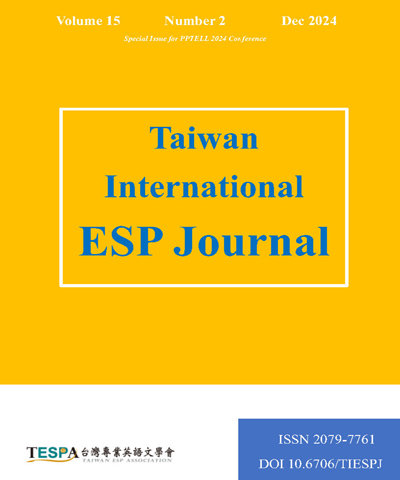
Taiwan International ESP Journal/台灣專業英語文期刊
- OpenAccess
台灣專業英語文學會,正常發行
選擇卷期
- 期刊
- OpenAccess
Needs Analysis (NA) is a preliminary step in developing academic courses; however, Iranian English for Academic Purposes (EAP) courses for students of medicine appear to be developed without conducting systematic NAs. As a result, the available courses might not appropriately address their students' EAP needs. Thus, this study explored the EAP needs of Iranian students of medicine and evaluated the efficacy of respective EAP courses in addressing these needs. To this end, a semi-structured interview guide and a questionnaire were developed to elicit data from EAP students and teachers of general medicine. Additionally, a checklist was developed to conduct non-participant observations of 12 sessions of EAP courses. The results revealed that students had several EAP needs relevant to listening, speaking, reading, writing, and academic exams. Nonetheless, these needs were not addressed appropriately in the EAP courses. This study lists the identified needs and shows their importance from the participants' viewpoints. Additionally, the inefficacies of the EAP courses are discussed, and several recommendations to improve them are offered.
- 期刊
- OpenAccess
Learners' writing in specific fields has not been studied to determine whether engineering writing exhibits distinct academic or non-academic lexical features. This corpus-based study examined the use and distribution of lexical verbs in the academic writing of L2 engineering undergraduates. To compile the Malaysian Mechanical, Electrical and Electronic Engineering Corpus of Student Writing (MECSW), 50 texts consisting of examination scripts, assignments, laboratory reports, project reports, proposals, and final year projects were annotated and analyzed. The MECSW comprises 151,227 tokens and 7,974-word types. The engineering students used all six verb forms totaling 14,629 words, but the past participle verb form was the most frequently used (n = 5,159) while the past tense form was the least used (n = 813). The top three words used in the past participle form were "used," "shown" and "based," reflecting the expository nature and report-writing style of the texts, and an emphasis on certain discourse segments. The results also showed that the base form (no conjugation) ranked third in frequency (n = 2,358) but learners often used the form inaccurately in place of other more "complex" conjugated verb forms. To profile the lexical verbs, the MECSW was compared to the British National Corpus for written texts. The top 50 lexical verbs in the MECSW were found to contain 70% academic vocabulary as listed in the Academic Keyword List. Another 20% of the verbs, which are not in the new-General Service List, can therefore potentially be described as specialized vocabulary, although the majority are non-technical in nature. The lexical verbs used by the students are largely in line with what is expected in academic writing. The study suggests that academic vocabulary instruction in the ESL classroom should emphasize verbs and verb forms as well as specialized non-technical or semi-technical verbs for new engineering students who are non-native speakers of English.
- 期刊
- OpenAccess
Over the past decades, genre study has become a well-trodden terrain for teaching English for Specific Purposes as well as for teaching professional and academic writing. Extensive research has been dedicated to the analysis of the rhetorical organization of research articles (RAs); nevertheless, RAs in Traditional Chinese Medicine (TCM), an emerging discipline in the academic discourse community, have not gained attention from genre researchers. Based on this research gap, this exploratory study aimed to identify the rhetorical move-step structure of the Introduction of TCM RAs. Towards this end, a total of 40 Introductions were compiled from five high-impact journals in the TCM discipline. Adopting Kanoksilapatham's (2005) framework as the main analytical tool, the current study found that TCM research articles follow the three-move structure identified by Kanoksilapatham (2005): Announcing the importance of the study, Preparing for the present study, and Introducing the present study. However, the analysis found several steps that were not covered in Kanoksilapatham's (2005) framework; namely, M1S4: Generalizations from previous studies, M2S2: Indicating a problem(s), M2S3: Presenting positive justification, M3S4: Stating the value of the study, and M3S5: Making hypothesis. The framework proposed as the outcome of this analysis is expected to have pedagogical implications, facilitating TCM students' and researchers' effective writing, and making their writing more acceptable for publication in international journals.

